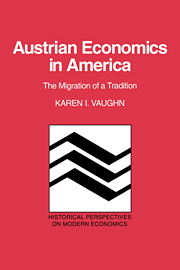Book contents
- Frontmatter
- Contents
- Preface
- Acknowledgments
- 1 Introduction
- 2 Carl Menger and the foundations of Austrian economics
- 3 Economic calculation and the rediscovery of Mengerian themes
- 4 Ludwig von Mises: Austrian economics in America
- 5 The Austrian revival
- 6 Defining the Austrian paradigm
- 7 Market process: the problem of order in Austrian economics
- 8 Austrian economics: which way forward?
- References
- Index
8 - Austrian economics: which way forward?
Published online by Cambridge University Press: 06 October 2009
- Frontmatter
- Contents
- Preface
- Acknowledgments
- 1 Introduction
- 2 Carl Menger and the foundations of Austrian economics
- 3 Economic calculation and the rediscovery of Mengerian themes
- 4 Ludwig von Mises: Austrian economics in America
- 5 The Austrian revival
- 6 Defining the Austrian paradigm
- 7 Market process: the problem of order in Austrian economics
- 8 Austrian economics: which way forward?
- References
- Index
Summary
I began this project to discover whether there is or could be a distinctive and separate approach to economics that follows naturally from the Austrian tradition. I approached this question by examining the origin and development of the modern Austrian school, since by understanding the history of the debates we could better understand the current literature and its place within the discipline of economics as a whole. During the course of this narrative, several persistent themes in the Austrian literature from Menger to the present argued for, at a minimum, an Austrian perspective and a set of Austrian questions: themes such as the importance of dynamic growth and development, the generation and function of knowledge in economic action, the uncertainties associated with processes in time, and the pivotal importance of diversity and heterogeneity in economic life. These themes suggested that Austrian economics cannot usefully be considered merely a variation on the economics of rationality and constrained maximization.
Despite these common themes, the division within current Austrian circles as typified by the debate between Kirzner and Lachmann presented in chapter 7, demonstrates that there is some deep disagreement among Austrian economists concerning the implications of those themes. There is not one, but at least two recognized approaches to doing Austrian economics, both sharing the same ancestors from Menger to the present, but differing greatly on the implications of the ideas of those ancestors. These two approaches differ most over the relationship between Austrian and neoclassical economics.
- Type
- Chapter
- Information
- Austrian Economics in AmericaThe Migration of a Tradition, pp. 162 - 178Publisher: Cambridge University PressPrint publication year: 1994

